Components of the Body Circulatory System
Added on 2022-11-25
25 Pages2548 Words222 Views
Running head: COMPONENTS OF THE BODY CIRCULATORY SYSTEM 1
Body circulatory system
Name
Institution
Body circulatory system
Name
Institution
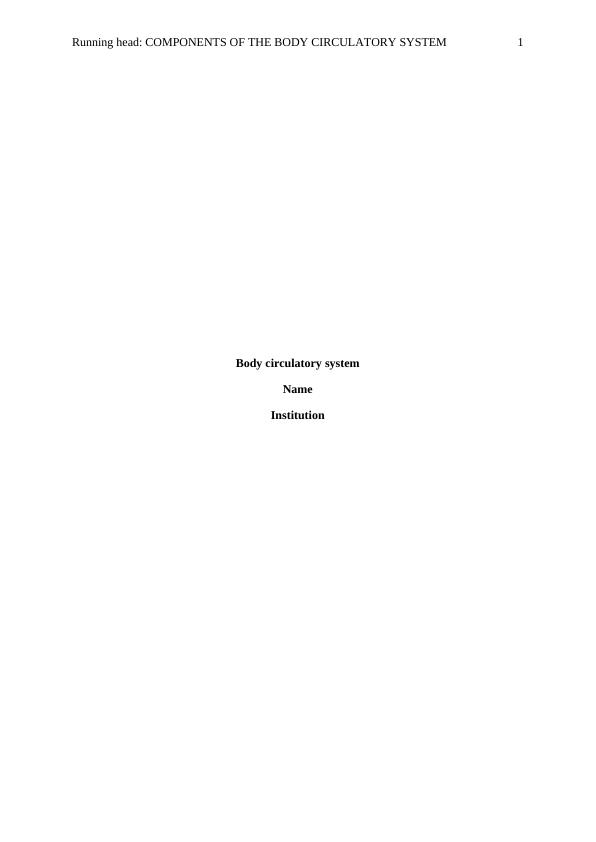
COMPONENTS OF THE BODY CIRCULATORY SYSTEM
Question one
a. The circulatory system is a network that is composed of blood vessels, blood and the
heart. Its main function is to supply various body tissues with oxygen, blood
hormones, and nutrients and also helps in the removal of different waste products
from the body tissues (Al-Soud & Rådström, 2014). The heart as a component of the
circulatory system is responsible for pumping of blood to different body tissues. The
heart is subdivided into four different chambers. These include the atria and the
ventricles. Each of these chambers exists on either side of the heart. The blood vessels
are the components that are responsible for carrying blood away or towards the heart.
Arteries carry oxygenated blood and supply it to different body tissues while the veins
carry most of the deoxygenated blood and waste products from the body tissues. The
blood is the transporting fluid for oxygen to different body tissues. It is comprised of
the haemoglobin that carries the oxygen to the body tissues.
Question one
a. The circulatory system is a network that is composed of blood vessels, blood and the
heart. Its main function is to supply various body tissues with oxygen, blood
hormones, and nutrients and also helps in the removal of different waste products
from the body tissues (Al-Soud & Rådström, 2014). The heart as a component of the
circulatory system is responsible for pumping of blood to different body tissues. The
heart is subdivided into four different chambers. These include the atria and the
ventricles. Each of these chambers exists on either side of the heart. The blood vessels
are the components that are responsible for carrying blood away or towards the heart.
Arteries carry oxygenated blood and supply it to different body tissues while the veins
carry most of the deoxygenated blood and waste products from the body tissues. The
blood is the transporting fluid for oxygen to different body tissues. It is comprised of
the haemoglobin that carries the oxygen to the body tissues.

COMPONENTS OF THE BODY CIRCULATORY SYSTEM
b. Tunica intima is the innermost layer of the artery. The layer comprises of the
endothelial cells which are thin in nature (Bellet, 2016). The second layer of the artery
is the tunica media. This middle layer is more muscular than the inner layer discussed
in the preceding statement. They are also very important in the adjustment of the
volume of blood that is required by different body parts. This achieved through
efficient dilation and the constriction o the arteries. The outermost layer of the arteries
is the tunica adventitia. It plays mostly the protection of the arterial vessels from any
possible damages. They are composed of rigid muscles than the tunica media muscles.
b. Tunica intima is the innermost layer of the artery. The layer comprises of the
endothelial cells which are thin in nature (Bellet, 2016). The second layer of the artery
is the tunica media. This middle layer is more muscular than the inner layer discussed
in the preceding statement. They are also very important in the adjustment of the
volume of blood that is required by different body parts. This achieved through
efficient dilation and the constriction o the arteries. The outermost layer of the arteries
is the tunica adventitia. It plays mostly the protection of the arterial vessels from any
possible damages. They are composed of rigid muscles than the tunica media muscles.
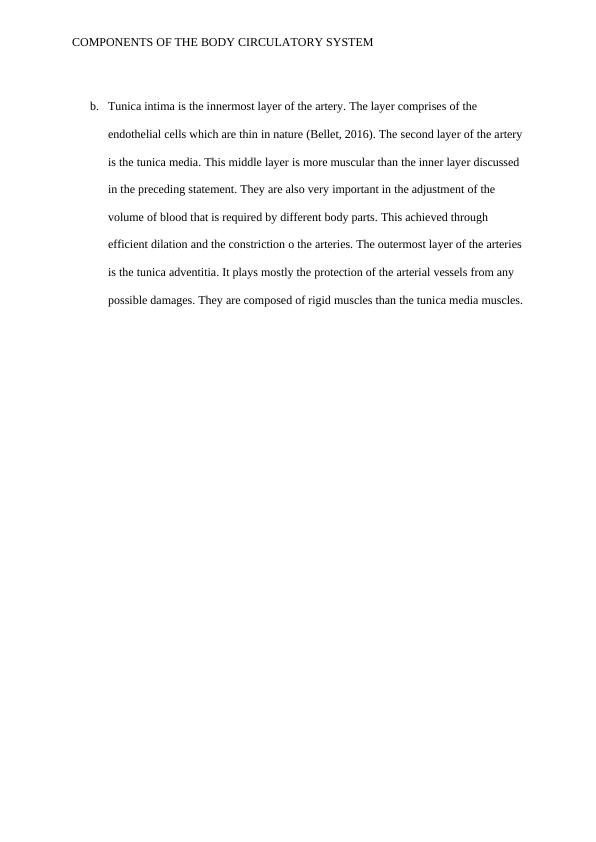
COMPONENTS OF THE BODY CIRCULATORY SYSTEM
c. The components of the layers of the veins and the arteries differ at different parts of
the circulatory system. Arterioles and arteries have much thicker walls in comparison
to the venules and the veins (Donovan, 2011). This is mainly due to their proximity to
c. The components of the layers of the veins and the arteries differ at different parts of
the circulatory system. Arterioles and arteries have much thicker walls in comparison
to the venules and the veins (Donovan, 2011). This is mainly due to their proximity to
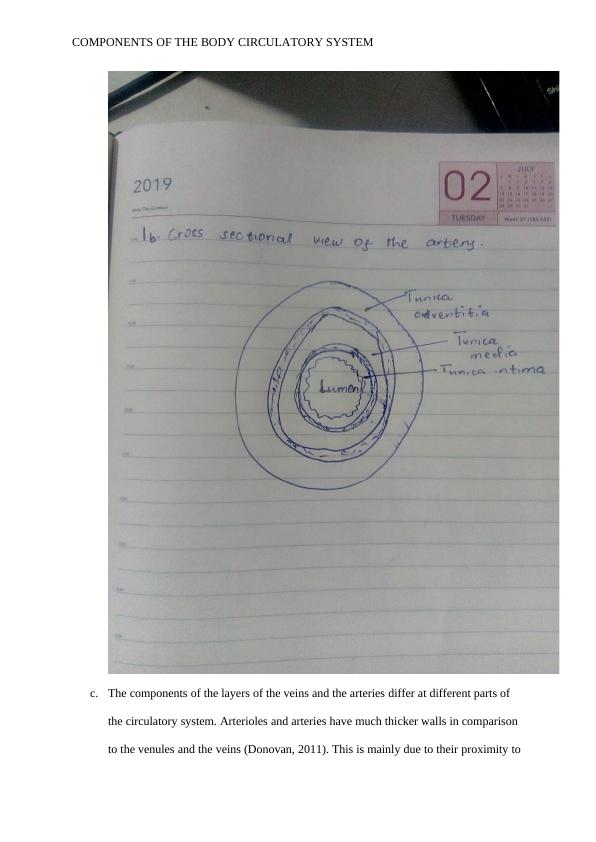
COMPONENTS OF THE BODY CIRCULATORY SYSTEM
the heart. The blood pressure at these parts is at a higher pressure thus is the main
reason why the arteries in his sections have thicker layers. The narrow lumen in the
artery is very responsible for the maintenance of the higher blood pressure evident in
these blood vessels. The thickness of the three layers of the blood arteries differ as
one moves away from the heart. Arteries that are closer to the heart have narrower
lumen and thicker layer so that the blood pressure at this distinct section is
maintained. The veins carry deoxygenated blood away from the body tissues. This
blood have low pressure. This is the reason why veins have wider lumen and narrower
walls that can easily support the low pressure blood flowing in these blood vessels.
the heart. The blood pressure at these parts is at a higher pressure thus is the main
reason why the arteries in his sections have thicker layers. The narrow lumen in the
artery is very responsible for the maintenance of the higher blood pressure evident in
these blood vessels. The thickness of the three layers of the blood arteries differ as
one moves away from the heart. Arteries that are closer to the heart have narrower
lumen and thicker layer so that the blood pressure at this distinct section is
maintained. The veins carry deoxygenated blood away from the body tissues. This
blood have low pressure. This is the reason why veins have wider lumen and narrower
walls that can easily support the low pressure blood flowing in these blood vessels.
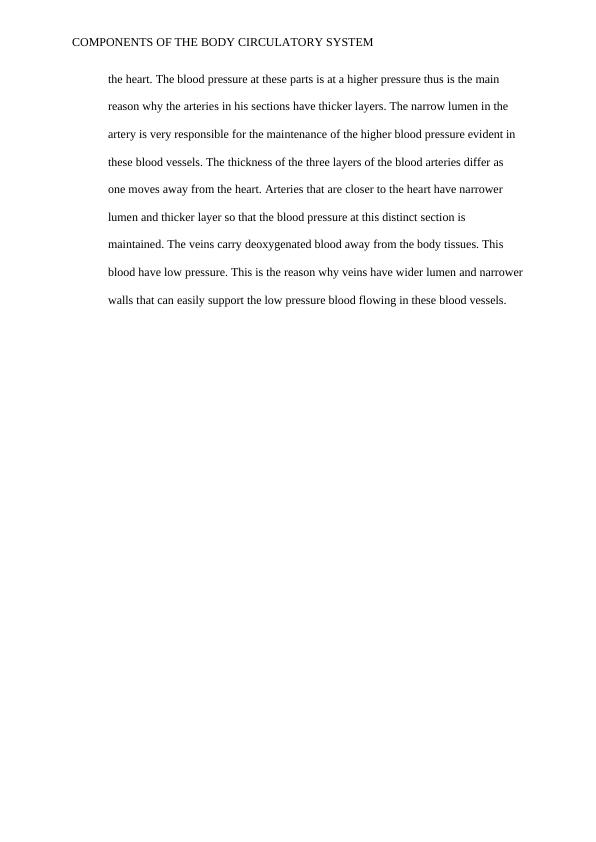
COMPONENTS OF THE BODY CIRCULATORY SYSTEM
Question two
a. Blood is a component which consists of plasma that circulates around the human
body. The amount of blood found within the human body is approximately 5 to 6
litters (Dye, 2019). Blood consists of various cells which are generally termed as the
formed elements of the blood. These include the red blood cells, white blood cells.
The red blood cells are also referred to as the erythrocytes ands are biconcave in
shape. They are rich in haemoglobin which is an iron rich protein. The production of
Question two
a. Blood is a component which consists of plasma that circulates around the human
body. The amount of blood found within the human body is approximately 5 to 6
litters (Dye, 2019). Blood consists of various cells which are generally termed as the
formed elements of the blood. These include the red blood cells, white blood cells.
The red blood cells are also referred to as the erythrocytes ands are biconcave in
shape. They are rich in haemoglobin which is an iron rich protein. The production of
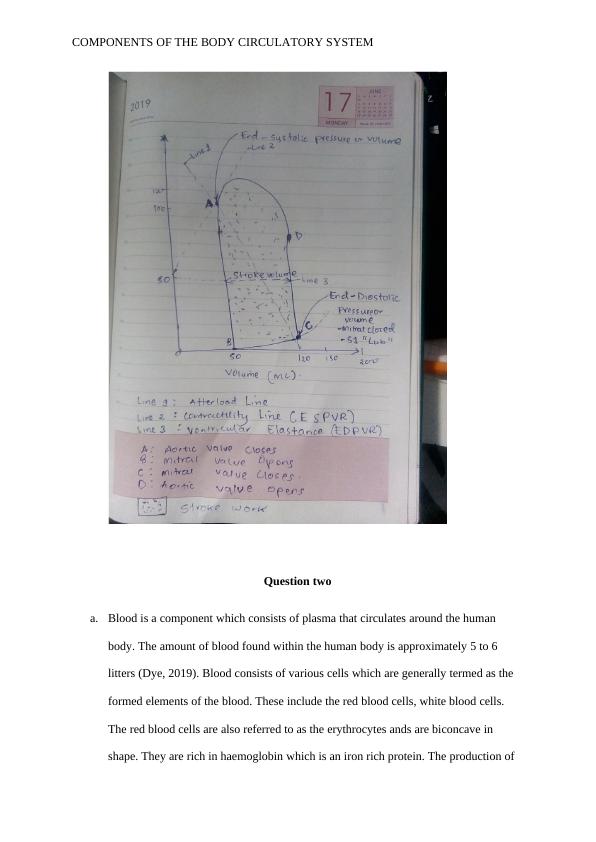
End of preview
Want to access all the pages? Upload your documents or become a member.
Related Documents
Assignment on Lecture Questionslg...
|4
|572
|11
Indication of Plaque Accumulation Reportlg...
|8
|941
|14
Transport and Respiration in Biologylg...
|27
|5047
|98
Description of How the Heart Pumps Blood in the Human Bodylg...
|6
|1149
|113
Pathophysiology | Assessment | 1lg...
|4
|465
|23
Case Study: 1 2 5 Case Study: 3 11 References 15 Case Study: 1 1. Cardiovascular System of the Bodylg...
|17
|3611
|314
